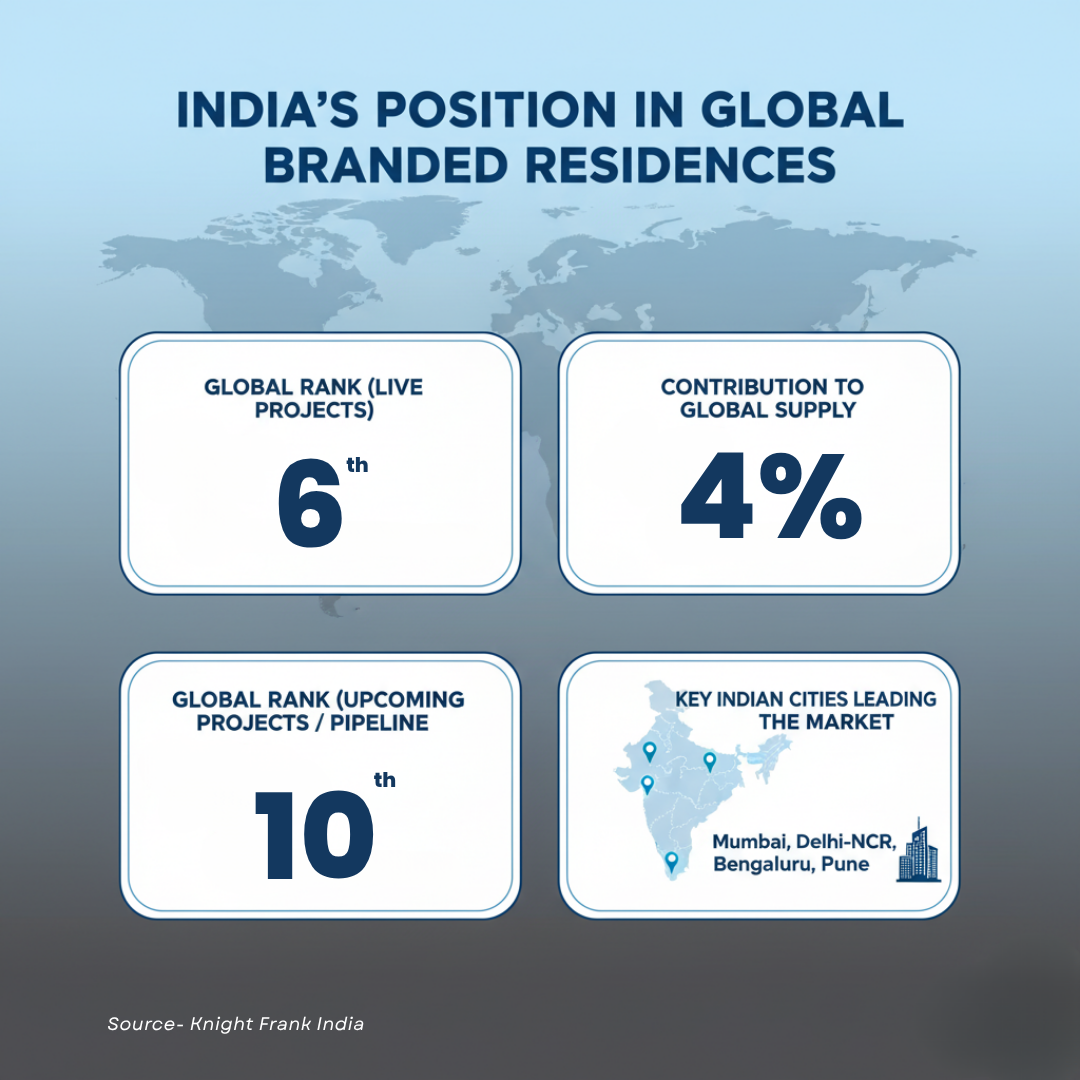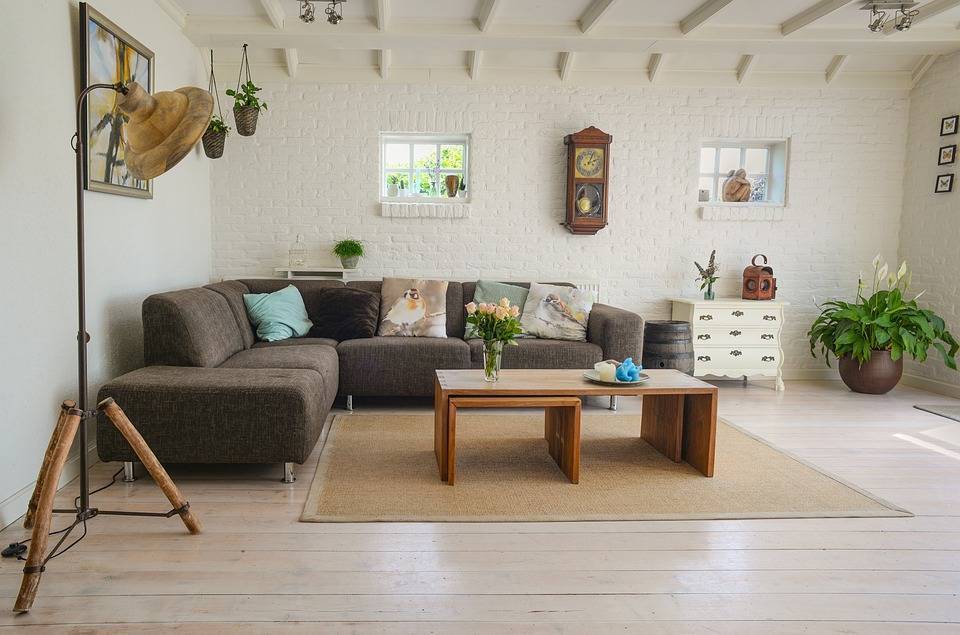India is cementing its position as a significant player in the global branded residences market. According to Knight Frank India’s The Residence Report 2025, the country ranks sixth globally in live branded residence projects, contributing 4% to the global supply. Mumbai, Delhi-NCR, Bengaluru, and Pune have emerged as the leading hubs driving this growth, reflecting India’s increasing prominence in premium residential development.
In the pipeline of upcoming projects, India ranks tenth worldwide, accounting for 2% of future global supply among the 83 countries surveyed. These figures hgighlight the nation’s growing appeal for investors and developers targeting high-end residential projects. Notably, in 2024, India was home to nearly 85,698 high-net-worth individuals (HNIs) with assets exceeding $10 million, representing 3.7% of the global HNI population, highlighting a robust domestic demand for branded residences.

What Are Branded Residences?
Branded residences are ultra-luxury homes developed in collaboration with globally renowned lifestyle and hospitality brands. These properties combine high-end living with the signature quality, style, and service standards of the brand. Esteemed names like Ritz-Carlton, Four Seasons, and Rustomjee have entered this segment, offering homes that reflect their iconic design aesthetics and attention to detail.
The core idea is to provide a complete luxury lifestyle, every aspect, from architecture and interiors to amenities and concierge services, is crafted to deliver an unmatched living experience. Unlike regular luxury homes, branded residences promise consistent excellence and personalized services, making them a coveted choice for discerning buyers seeking prestige, comfort, and exclusivity.A
Rapid Expansion of the Branded Residences Sector
The branded residences sector has witnessed remarkable growth over the last decade. The number of branded residence schemes globally has surged from 169 in 2011 to 611 in 2025, with total units projected to increase from just over 27,000 in 2011 to more than 162,000 by 2030.
Hotel brands continue to dominate the segment, accounting for 83% of existing schemes, although this share is expected to slightly decline to around 80% in the coming years. Liam Bailey, Global Head of Research at Knight Frank, commented: "The branded residences sector has experienced strong, sustained growth, with momentum accelerating since 2023, fueled by rising demand for branded living and developers’ appetite for premium positioning."
Shifts in Global Market Dynamics
Globally, the center of branded residence development is gradually moving eastward, with Asia-Pacific markets such as India and Thailand, along with the Middle East, gaining ground.
- North America remains the largest market, particularly the United States, but its share of pipeline projects is declining, from 32.7% of live schemes to 26.2% of future projects.
- Middle East shows rapid growth, especially in the UAE and Saudi Arabia, with pipeline projects accounting for 26.7% compared to 15.9% of live projects, reflecting aggressive development in the region.
Asia-Pacific maintains a strong pipeline, but its overall share is expected to ease slightly. Developers are increasingly targeting growth markets in the Middle East, Latin America, and beyond. Additionally, future developments are showing a growing preference for standalone branded residences, moving away from traditional hotel co-location models, particularly in North America and the Middle East.
Developers are increasingly favoring standalone branded residences, moving away from the traditional hotel co-location model, particularly in North America and the Middle East. Liam Bailey noted: "While new lifestyle and luxury brands enter the sector daily, 83% of existing projects remain hotel-led. This dominance is likely to continue, albeit slightly reduced over time."
Adding on the Growling Trend
In June 2025, IBEF published a report of of World Wealth Report 2025 by Capgemini Research Institute., that stated India witnessed a significant surge in wealth in 2024, adding over 33,000 new millionaires, The country’s High-Net-Worth Individual (HNWI) population grew 5.6% to 3,78,810, while total HNWI wealth rose 8.8% to Rs. 1,28,74,500 crore (US$ 1.5 trillion), making India one of the fastest-growing wealth markets globally. Most new millionaires fall under the “Millionaires Next Door” category, holding investable assets between Rs. 8.6 crore (US$ 1 million) and Rs. 42.9 crore (US$ 5 million). The country also recorded 4,290 Ultra HNWIs—those with over Rs. 257.5 crore (US$ 30 million)—who collectively held Rs. 45,89,931 crore (US$ 534.77 billion). Wealth growth was driven by a strong equity market (Sensex up 8.2%), rising domestic consumption, entrepreneurship, and inheritance trends, with 50% of HNWIs expected to inherit wealth by 2030 and 93% by 2040.
India’s Growing Luxury Housing Market
Within India, Mumbai, Delhi-NCR, Bengaluru, and Pune are the key markets driving the branded residences trend. These cities cater to a mix of high-net-worth individuals and aspirational buyers seeking premium amenities, branded experiences, and a luxury lifestyle.
The growth of branded residences in India reflects multiple factors and emerging trends:
-
Rising Urban Affluence and Disposable Income: India’s urban population with high purchasing power continues to grow, supported by rising salaries, business profits, and entrepreneurial wealth.
-
Increasing Domestic and International Investor Confidence: Real estate investments in India have seen robust inflows from both domestic and foreign investors, driven by stable policies, regulatory transparency, and the growth of organized luxury real estate developers.
-
Growing Demand for Lifestyle-Focused Residential Products: Buyers increasingly seek residences that offer integrated lifestyle solutions including fitness centers, landscaped gardens, swimming pools, children’s play zones, smart home technology, and curated social spaces.
-
Preference for Branded and Managed Living: Luxury buyers are attracted to branded residences that offer association with global hotel brands or renowned lifestyle brands, ensuring quality services, maintenance, and a premium living experience.
-
Rise of Standalone Luxury Developments: While co-located hotel-branded residences remain popular, there is a noticeable shift toward independent, standalone luxury residential projects that offer exclusivity, privacy, and differentiated design.
-
Digital and Smart Infrastructure Integration: Luxury projects increasingly incorporate IoT-enabled amenities, energy-efficient systems, AI-powered security, and smart home automation, aligning with global trends in tech-enabled living.
-
Shift Toward Smaller, Aspirational Luxury Units: Developers are catering not just to ultra-rich buyers, but also to aspirational customers seeking 1–2 BHK luxury apartments with premium amenities, making branded residences more accessible to a wider audience.
-
Sustainability and Eco-Friendly Designs: There is a growing emphasis on sustainable building practices, green certifications, water recycling, energy-efficient lighting, and eco-conscious landscaping, reflecting global luxury real estate trends.
-
Integration with Urban Development and Connectivity: Luxury developments are increasingly located in well-connected areas with proximity to major employment hubs, metro lines, airports, and social infrastructure, enhancing convenience and lifestyle appeal.
India’s emergence as a global hub for branded residences highlights the country’s growing influence in the luxury real estate segment. With Mumbai, Delhi-NCR, Bengaluru, and Pune leading the market, the sector is benefiting from rising affluence, urban expansion, and evolving buyer preferences. As domestic and international investors continue to back premium projects, and developers innovate with standalone luxury offerings, India is set to solidify its position among the world’s top branded residence markets. The next decade promises not just growth in numbers, but the elevation of lifestyle standards and the creation of iconic urban living experiences across the nation.









.png)